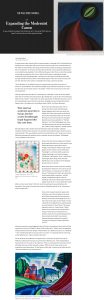Expanding the Modernist Canon – WSJ 2

A hundred years ago, American life was modernizing at a dizzying clip. The automobile and telephone were coming into wide use and electrical power grids were revolutionizing city life, while the world of ideas was being transformed by Freudian psychology and Einstein’s theory of relativity. “At the Dawn of a New Age: Early 20th-century American Modernism,” a new exhibition opening May 7 at the Whitney Museum in New York, surveys that dynamic era through an expansive look at its art. More than 60 works—paintings, drawings, sculptures, prints and photographs—represent over 45 artists, from famous names like Georgia O’Keeffe and Stuart Davis to less familiar figures of that era whose work has come into the collection only recently or languished in storage, unseen for decades.
“At the Whitney, we’ve definitely started to expand what we present as the story of America,” said exhibition curator Barbara Haskell. Early modernist American art “wasn’t just the story of a few great masters,” she added. “There were so many more artists who were important.”
Take the painter Henrietta Shore, a contemporary of O’Keeffe. “Critics at the time talked about the two of them in the same breath,” Ms. Haskell said, “some of them even preferring Shore’s work.” Shore’s “Trail of Life” (ca. 1923), acquired by the Whitney this year, is one of the first paintings to greet visitors to the show, alongside canvases by Marsden Hartley, Agnes Pelton—the subject of a solo Whitney show in 2020—and Oscar Bluemner.
Most American modernists spent time in Europe, but their creative breakthroughs largely happened after they came home.
Most American modernists spent time in Europe, but their creative breakthroughs largely happened after they came home, Ms. Haskell said. Those who stayed on this side of the Atlantic absorbed European art from afar, filtering new movements and ideas through a distinctly American sensibility. In “Untitled (Bathers)” (ca. 1917), Philadelphia-born artist Carl Newman packs the canvas with elements that “make no sense together,” said Ms. Haskell,
like nude figures and a rainbow, boat and mountain range. The mashup “radiates a youthful, unselfconscious innocence. It’s as if he had no inhibitions about what he could or could not paint.” The same might be said of Florine Stettheimer, who “breaks every rule by filling her paintings with feminine colors, ornament, excess and whimsy,” challenging “every standard of ‘serious’ art.”
In New York, the German émigré artist Winold Reiss taught Hawaiian-born artist Isami Doi and Harlem Renaissance powerhouse Aaron Douglas. The influence of Reiss’s bold, starkly graphic style is evident in Doi’s 1924 linocut “Moonlight,” and in three 1926 woodcuts by Douglas depicting scenes from the Eugene O’Neill play “The Emperor Jones.” With the Doi and Douglas prints hung side by side, Ms. Haskell said, “you can almost see the dialogue between those two artists.”
Many of the show’s artists used color riotously, including Oscar Bluemner, who came to the U.S. from Germany as a young man in the 1890s. In Europe, “Kandinsky and others had argued that colors had parallels in emotions,” said Ms. Haskell, and Bluemner agreed. “But the simplicity of his forms and the hypersaturated quality of his colors,” as in the landscape “Space
Motive, a New Jersey Valley” (1913-14), “give his paintings an unusual boldness and dynamism,” she noted, to the point that works by Kandinsky and his circle “seem almost tame in comparison.”
Some artists merged modernist approaches with their own cultural traditions. Bay Area artist Chiura Obata made ink and watercolor sketches of Yosemite and the High Sierra; on a trip to his native Japan, he used them to create a portfolio of woodblock prints, depicting what he called America’s “Great Nature” in intense, expressive colors. In “Street Scene” (1926), Chinese-born artist Yun Gee interpreted the energy of San Francisco’s Chinatown as a rhythmic rush of color and softened geometric forms. Asked why he didn’t use classical Chinese painting techniques, Gee replied, “Because I am living in a modern industrial society.”
Abstraction proved a surprisingly good match for the era’s optimism. Like music itself, the organic flow of color in O’Keeffe’s “Music, Pink and Blue No. 2” (1918) carries an emotional intensity beyond conscious thought. “Noise Number 13” (1925) by the poet E. E. Cummings —who considered himself as much an artist as a writer—is a dizzying whirl of colors that, as Ms. Haskell puts it, “ignore aesthetic decorum.”
For Ms. Haskell, the exhibition is an opportunity to reassess and expand not only the Whitney’s collection but its take on a pivotal era of American art. “This is happening in museums all over the country,” she observed. “There’s a realization that museums weren’t reflecting America, and that needed to change.” With its mix of iconic works, recent acquisitions and rediscoveries, “At the Dawn of a New Age” is poised to tell what she calls “the most exuberant story of that period.”